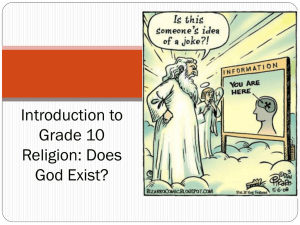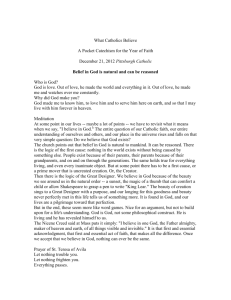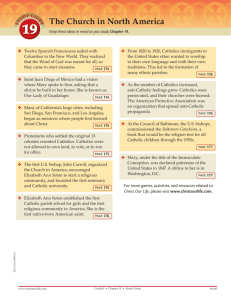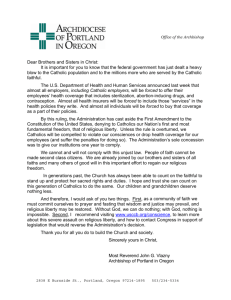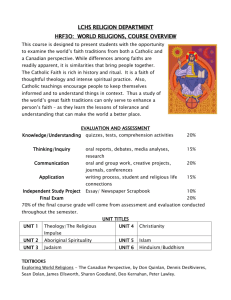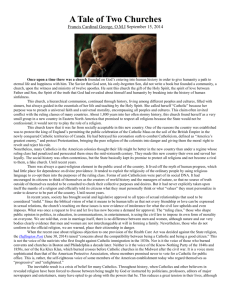Seeking the Seekers
advertisement
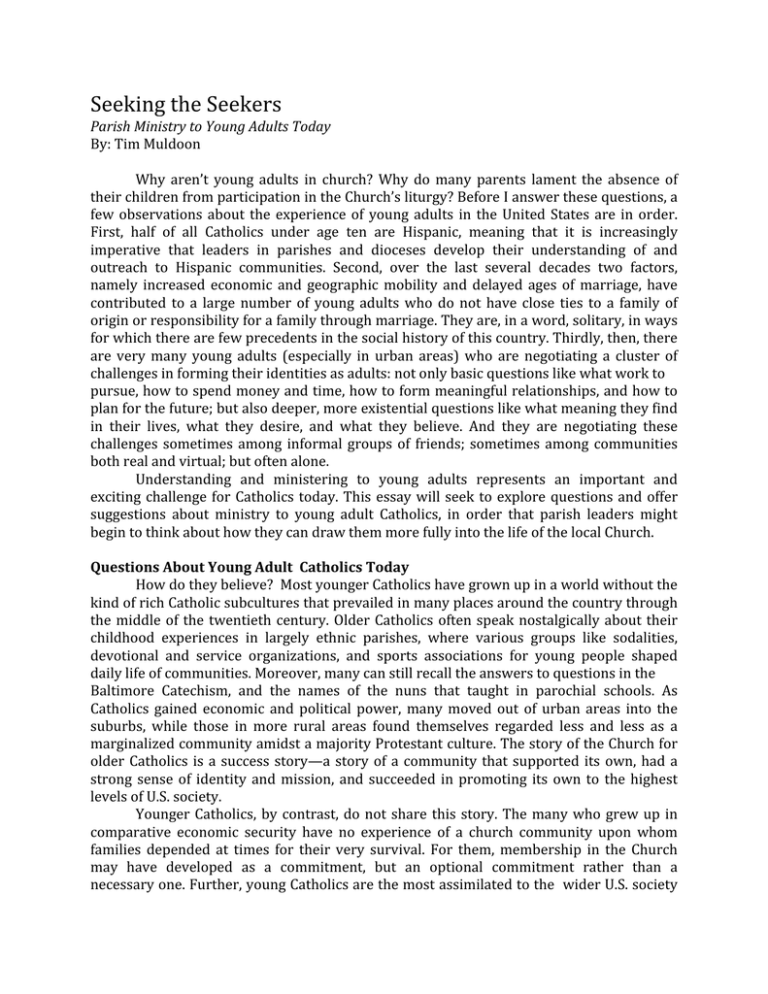
Seeking the Seekers Parish Ministry to Young Adults Today By: Tim Muldoon Why aren’t young adults in church? Why do many parents lament the absence of their children from participation in the Church’s liturgy? Before I answer these questions, a few observations about the experience of young adults in the United States are in order. First, half of all Catholics under age ten are Hispanic, meaning that it is increasingly imperative that leaders in parishes and dioceses develop their understanding of and outreach to Hispanic communities. Second, over the last several decades two factors, namely increased economic and geographic mobility and delayed ages of marriage, have contributed to a large number of young adults who do not have close ties to a family of origin or responsibility for a family through marriage. They are, in a word, solitary, in ways for which there are few precedents in the social history of this country. Thirdly, then, there are very many young adults (especially in urban areas) who are negotiating a cluster of challenges in forming their identities as adults: not only basic questions like what work to pursue, how to spend money and time, how to form meaningful relationships, and how to plan for the future; but also deeper, more existential questions like what meaning they find in their lives, what they desire, and what they believe. And they are negotiating these challenges sometimes among informal groups of friends; sometimes among communities both real and virtual; but often alone. Understanding and ministering to young adults represents an important and exciting challenge for Catholics today. This essay will seek to explore questions and offer suggestions about ministry to young adult Catholics, in order that parish leaders might begin to think about how they can draw them more fully into the life of the local Church. Questions About Young Adult Catholics Today How do they believe? Most younger Catholics have grown up in a world without the kind of rich Catholic subcultures that prevailed in many places around the country through the middle of the twentieth century. Older Catholics often speak nostalgically about their childhood experiences in largely ethnic parishes, where various groups like sodalities, devotional and service organizations, and sports associations for young people shaped daily life of communities. Moreover, many can still recall the answers to questions in the Baltimore Catechism, and the names of the nuns that taught in parochial schools. As Catholics gained economic and political power, many moved out of urban areas into the suburbs, while those in more rural areas found themselves regarded less and less as a marginalized community amidst a majority Protestant culture. The story of the Church for older Catholics is a success story—a story of a community that supported its own, had a strong sense of identity and mission, and succeeded in promoting its own to the highest levels of U.S. society. Younger Catholics, by contrast, do not share this story. The many who grew up in comparative economic security have no experience of a church community upon whom families depended at times for their very survival. For them, membership in the Church may have developed as a commitment, but an optional commitment rather than a necessary one. Further, young Catholics are the most assimilated to the wider U.S. society among the generations in the Church, suggesting that they do not perceive their Catholicism as summoning from them a difficult decision in the face of persecution or pressure. For them, membership in the Church is more like membership in a club or any other type of voluntary organization. At best, their commitment is a sincere sense that God calls them into worship in the community of faith; but at worst, their commitment is one more obligation that can easily be dropped if something more interesting comes along. Underlying this posture toward Church membership is an important observation that applies to all kinds of choices that young people face in their lives. They have grown up in a U.S. culture driven by consumer imperatives: everything from the kind of education they receive, to the way they are taught to use money, to the expectations they develop about marriage are shaped by implicit understandings of how to use the precious resources of their time and energy. In a world of seemingly limitless choices—from cereal to cars to colleges—everything becomes an object for consumption, including even religious truth claims and the communities who profess them. They have friends who come from many religious traditions (or no particular religious tradition), and therefore find it hard to make the simple claim that Catholic faith is necessarily the best. They navigate their way in a global economy and have information about the world at their fingertips, and so know that the majority of the world is not Catholic. In light of these factors, young people approach the Church as they do any other organization: as smart consumers, who need to be persuaded that their participation is worth their time and energy. To be sure, the roles that families play in the faith lives of young adults ought not be underestimated. Young Catholics will still see themselves as Catholic even if they have not engaged in any meaningful practices of the faith for years. There is, it seems, still a lingering truth to Andrew Greeley’s observation that there is something unique about the Catholic imagination, which shapes the way young people look at the world. But what is strength is also a liability: we are good at preserving the practices of our faith because we know that our traditions take hold of people’s imagination; but because we know this truth, we do not often see the imperative to develop new ways of celebrating it. It is precisely this point which, I suggest, is the crux of our growth as a faith community in the twenty‐first century: we must bring from the storehouse of Catholic traditions both the old and the new, those things which appeal both to lifelong “in their bones” Catholics and young “seeker” Catholics. We must be prepared to ask what resources from our traditions have cultivated our sacramental imagination—that is, our ability to discern the presence of God in the community of faith through manifold symbols, sacramentals, and sacraments—and then ask what resources we might use to invite young people to similarly discern God’s presence. Some specific examples will illustrate the potential difficulty with this question. What if, for example, we should learn that what young people really want is Latin mass, priests in cassocks and nuns in habits, weekly confession, meatless Fridays throughout the year, recited Angelus prayers in the middle of the school‐ and workday, regular rosary prayer, Eucharistic adoration, and so on? What if, in other words, the practices that will draw young people into more vibrant participation in the life of the faith community are precisely those practices, which so many older Catholics left behind in the rush of post‐ Vatican II enthusiasm? Such questions challenge us to consider what we understand Church membership to be about: Is it about having a nurturing community? A good sermon? A place of comfort? A dramatic experience of worship? I am not suggesting that a return to these older forms of public and private devotion are the answer to how to develop the faith lives of all young adults in the Catholic community, even though it is clear to me that some young adults are attracted to them. I am, however, suggesting the need to remind ourselves that what older Catholics have left behind in their own faith journeys might yet be helpful elements in the lives of those at earlier stages of the pilgrimage toward God. Some young people do yearn for an experience of mystery in worship, an experience they do not find in other dimensions of their lives. Some may desire the kinds of romanticized, Hollywood scenes of Catholic worship, scenes which, tellingly, often look more pre‐Vatican II than post‐Vatican II. To be sure, it is still important for older Catholics to share their stories of why they were relieved when things changed; but it is also important to ask why many young people want to experience mystery. Perhaps it is because they see the Church as a place willing to explore the mystery of God, in contrast to the hyper‐ordered world they live in, which does not often attend to the most compelling questions about life and death. Perhaps what they want is a community as serious about the mystery dimension of the spiritual life— that is, the dimension of spirituality that is willing to admit that our ability to speak about God is limited—as they are in their private lives. It has become a truism to speak about young people as spiritual but not religious; our challenge is to offer a religious community that fosters, deepens, and challenges them to become more authentically spiritual. What Do They Think About the Church? At present, a minority of young adults think of the Church as a community that nourishes their spirituality. For many others, the Church may be their home, if parents or grandparents modeled faith for them. It may be the community that they return to for holidays. It may be the place they seek out when they want to get married or baptize a child. But generally speaking, young adults do not perceive the Church as a group of people that will help them grow in their spiritual lives and in their ability to practice love and justice. And I am suggesting that thinking about the Church in these ways, and asking how our community might embody these aspirations, will draw young adults back into fuller participation. Why? For several reasons. First, we live in the post‐sexual abuse Church. Claims to moral authority are assumed by a minority who have grown up in strong Catholic families, but the majority are likely to view any claims to authority with more than a little bit of skepticism. They must be persuaded and shown how the Gospel transforms lives; words simply won’t do it. Second, ours is an information age; religious truth claims (again, words) are as much consumer items as toothpaste and apparel. If the primary PR about the Church has to do with statements from bishops and the Vatican, it is unlikely that such statements will draw more than those young people already committed to deepening their understanding of the faith. What is needed, in a word, are saints: people committed to showing how their Catholic faith makes them more loving, more committed to justice, more courageous in their public witness. Words won’t do; personal witness will. Third, young people are interested in spirituality but do not now perceive the Church as contributing to it in a meaningful way. If we are to draw young adults into the life of the faith community, we must think about how our parishes help deepen people’s spiritual lives. Are liturgies perfunctory? Are sermons arcane? Are there opportunities to pray in small groups outside of Mass? Are there opportunities for service and—equally important—opportunities to reflect on service in the context of shared prayer? Fourth, young people often lack models of meaningful relationships in their lives, and so if a parish community practices authentic hospitality and offers them opportunities to cultivate meaningful relationships across customary lines of age, economic class, race, and so on, it will be a place where they will learn the skills of agapic love. By cultivating these relationships, parishes will gently invite them to see that the practice of spirituality is not ultimately something one can do on one’s own terms, but rather the challenge to deepen one’s love of God through the sometimes difficult practice of loving others. What Does the Church Offer to Young Adults? What Might It Offer? The Church offers Christ to young adults—it is the community moved by love to be Christ for the world; the community willing to be formed not by the exigencies of consumerism, or political debate, or any other balkanizing forces, but rather seeking to be conformed to the Body of Christ through conversion, repentance, and reconciliation. Our constant invitation to young adults must be this: We want you for who you really are, not for what you do. What Will This Invitation Look Like in Practice? Here Are Some Ideas: Theology on Tap. This is the most successful ministry to young adults over the past quarter century, rooted in the invitation to young people to share time together reflecting on the Gospel. A good Website. Show the young adults in your community that you understand the way they inhabit the world and seek information. Include links to various ministries they can be involved in; links to Catholic Websites where they can learn more about their faith; links to small communities where they can share faith or read scripture; links to vocations Websites and volunteer opportunities after college. Send the parish bulletin via email, and have a section devoted to young adults. Sensitive liturgy. Not all Catholics are in families; be sensitive to how language sounds to people who are single, especially if not by choice. Marriage and baptismal preparation. Many parishes miss the opportunity to make these programs places where young married people can get to know each other and grow together. Devotions. Invite smaller groups to use worship space for their own devotions. For example, a Sant’Egidio group prays together in different worship spaces near where I live. Service opportunities. Issue invitations to specific young people to lead trips to soup kitchens or nursing homes, and provide leadership in helping the groups to reflect meaningfully on their experiences in the context of prayer. RCIA. Give young adults the chance to meet one another in the context of their own preparation for the sacraments. What Do Young Adults Offer to the Church? By inviting young adults into our midst, and by being willing to mentor them in faith, we will find ourselves having to reflect critically on our own faith lives. It is precisely this process of reflection which I hope will help us to see more clearly the ways that God is moving in our midst, challenging us to discern what brings us closer to God and what draws us further away. The dynamics of this process are reflective of the promise of a God whom Jesus reveals to us as one who always makes old things new. Tim Muldoon is the author is Seeds of Hope: Young Adults in the Catholic Church in the United States (Paulist, 2008) and the forthcoming Longing to Love: A Memoir of Desire, Relationships and Spiritual Transformation (Loyola, 2010). He teaches in the Boston College Honors Program and serves in the Office of University Mission and Ministry. Copyright 2009 CHURCH Magazine, published by the National Pastoral Life Center, 18 Bleeker St., New York, NY 10012. Used by permission.
